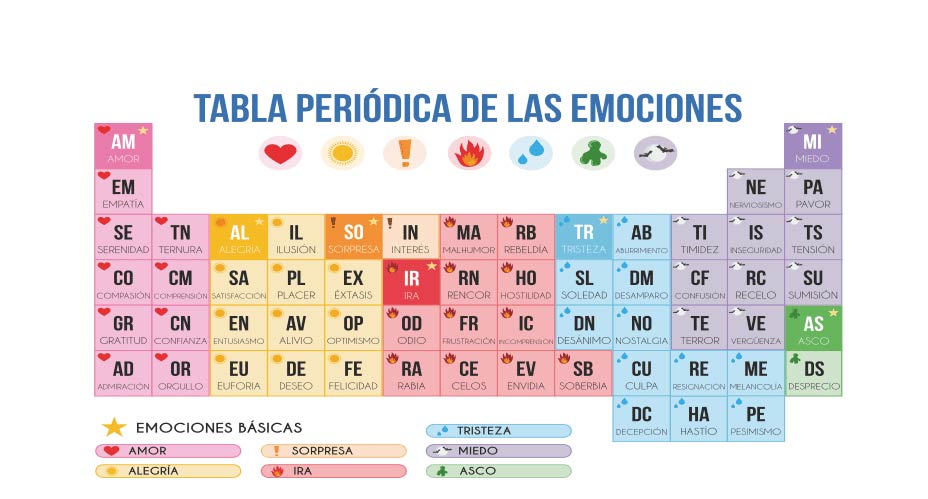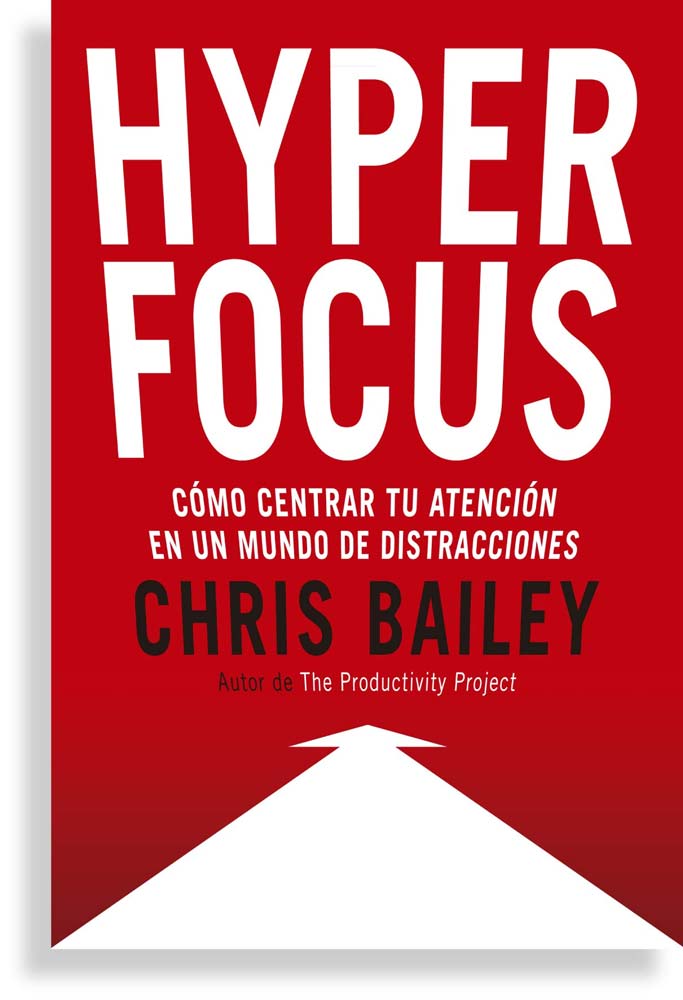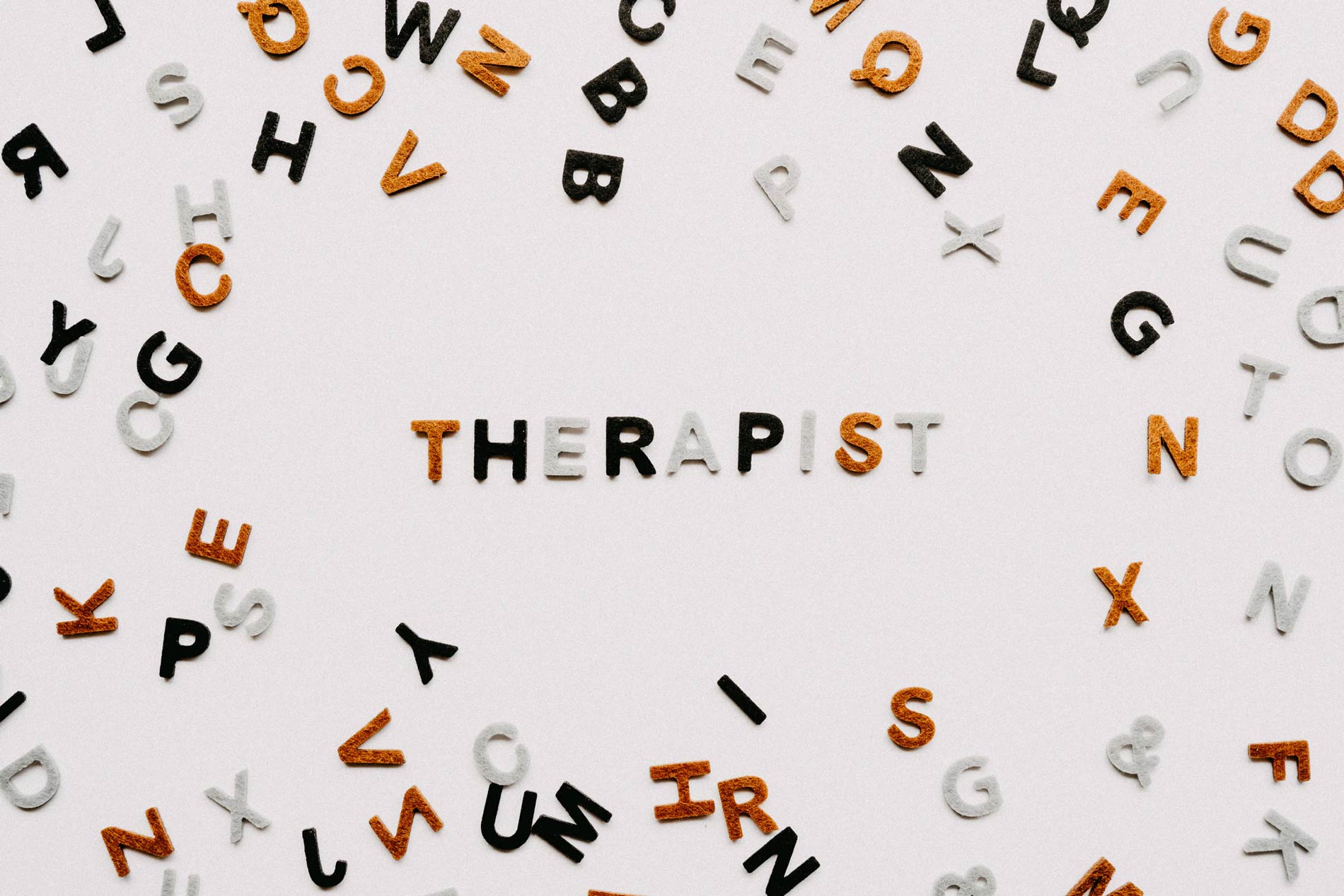Tools for identifying and expressing emotions
Why is it important to identify and express emotions properly?
Emotions provide important information about what is happening around us, how external events affect us and what they mean to us. Emotions also inform about the impact of internal events such as thoughts or physiological responses. Therefore, emotional responses to external or internal events are guides to our behavior, set us to behave in one way or another, tell us what to do depending on the emotion we are feeling.
If we do not know how to properly identify the emotions we feel, it is very likely that we will have difficulty managing our feelings, reflecting on why we feel the way we do and what we need to do to change our emotional state. Therefore, it is very important that we know how to identify emotions properly and to observe to which thoughts they are related to, so that we can make decisions to manage our emotions and respond to the situation we are facing.
The skills to identify and express emotions need to be fostered in childhood so that children develop an emotional system that allows them to manage and handle emotions properly. However, sometimes, these skills have not been adequately developed during this stage of life and we see adults with difficulties in identifying, expressing and managing their emotions. Sometimes, people with these difficulties can only determine if they feel "good", "so so" or "bad", but they do not know how to identify exactly what emotion they are feeling. At other times, they are able to differentiate between basic emotions (such as joy, sadness, fear, anger, disgust, and surprise), but have difficulty being more specific with more complex emotional states.
Below are some tools and resources that can be helpful in developing the skills to identify and express emotions. All of them can be used with adults, and some of them, with children, depending on their level of emotional development.
Circle of emotions

The Circle of emotions is a very useful tool to identify and name emotions. This circle is composed by the name of different emotions, which are categorized into basic emotions, in the inner part of the circle, and more specific and complex emotions, in the outer part of the circle.
The Circle of emotions provides rich and precise vocabulary to identify and name emotions. Sometimes it is necessary to go deeper into the meaning of the more complex emotions to learn to differentiate between similar but different emotions within the same emotional category (for example, differences between being apathetic or indifferent).
Along with naming and describing emotions, it is also very important to identify where in the body this emotion is located and how it feels (e.g., "when I feel angry I feel my forehead shrink and I feel pressure in my head and my chest"; "when I feel scared I feel it in the pit of my stomach"). Locating the emotion in the body helps in the process of identifying the emotions.
In addition, it is important to investigate the thoughts and behaviors associated with emotions, so that we understand the cause of our emotions and how they influence our thoughts and behavior, and vice versa.
Periodic table of human emotions

The Periodic table of human emotions is a tool similar to the circle of emotions, which has the same goal: identifying and naming emotions. In this case, we also find different emotional categories, which in turn are divided into more specific emotions.
This tool is recommended when the abilities to identify and name emotions are somewhat limited. If that is the case, it may be more useful to start by using the periodic table instead of the circle of emotions, because it contains fewer emotions, and these are less complex than those found in the circle.
As we did with the circle of emotions, part of the process of identifying and naming emotions involves locating the emotion in the body, and exploring the thoughts and behaviors associated with the emotion.
Book “Emocionario” by Cristina Núñez (only available in Spanish)

The Emocionario is a book that contains the description and graphic representation of a great variety of emotions and feelings. This book can be considered an emotional dictionary.
It is a very useful book to learn how to identify emotions adequately, since not only describes the different emotional states, but also helps to distinguish between them by showing how some emotions are related to others and explaining the possible causes of emotions.
This book is mainly targeted towards children. However, it is also a very useful resource for adults who have difficulties identifying their emotions. Therefore, this book is highly recommended for anyone involved in children's education (e.g., parents, teachers, etc.), and for adults who want to deepen and improve their emotional skills.
The simplicity and concreteness with which the different emotions are described makes this book a great tool for identifying and expressing emotions, both in and outside therapy.
Books “El laberinto del alma – The Labyrinth of the Soul ” and “Diario de emociones – Emotion’s diary” by Anna Llenas (only available in Spanish)
El Laberinto del Alma – The Labyrinth of the Soul is another reference book for identifying emotions and feelings. This book, like the Emocionario, is also considered an emotional dictionary, but unlike this one, El Laberinto del Alma is aimed at adults and adolescents, as it describes feelings of greater emotional complexity (for example: bonding, empathy, abandonment, toxicity, emotional blindness, etc.).
Especially interesting are the graphic representations accompanying the description of each of the emotions/feelings presented in the book, since they capture in a very precise way the essence of the emotion described.
The graphic representation of emotions is a very important resource to help develop the skills to identify and express emotions, because on many occasions, images are more powerful when it comes to transmitting what the person is feeling, than just identifying and naming the emotion.
Precisely, it is the graphic representation of emotions what is targeted in the book Diario de emociones – Emotion’s diary. This book is composed of different exercises to identify and express emotional states. Among them we can find exercises to connect with different emotions and draw them (e.g., "listen to a sad song and let yourself go" expressing graphically how it makes you feel); exercises to locate the emotion in the body and color it with the color that represents that emotion for us; exercises to express of our fears; etc.
The emotional expression through drawings, images, and colors besides facilitating the identification of emotions is also a therapeutic tool of great value in the process of managing and channeling emotions. Therefore, Diario de emociones is a highly recommended book to explore our emotional world and our way of expressing how we feel.
Dixit cards

The phrase "A picture is worth a thousand words" is especially applicable in the case of the expression of emotions, as sometimes pictures can capture the emotional world much more accurately than words themselves.
Sometimes it is difficult to put into words what we are feeling, because we may not know what we are feeling, or we may not have precise vocabulary to describe the complexity of our emotional world. For this reason, the cards of the board game Dixit can be a great resource to help develop or improve the skills to identify and express emotions.
These cards are composed of a great variety of images, which besides having great aesthetic value, are very symbolic and have lots of details, so they are very useful to represent the variety and complexity of emotional states, including representing the thoughts associated with those emotions.
Obviously, the meaning that each person attributes to each image is subjective; that is, an image can represent one emotion or emotions for one person and represent different emotions for another. That is why it is very important to use this tool so that the person can explain what it means to him or her. It is especially important that in this process we explore thoughts and behaviors associated with the images of the cards.
It is highly recommended to combine the Dixit cards with the circle of emotions or the periodic table of human emotions, so that the images represented in the cards are paired with the name of emotions.
Therefore, the use of Dixit cards is especially useful for people who have difficulty identifying emotions or for those who only have the ability to differentiate between basic emotions.
Drawings, collages and play dough
Other resources to help in the process of identifying and expressing emotions can be drawings, collages or the representation of emotions with play dough. These resources are very interesting as a means of shaping and externalizing the emotional world, and as a means of managing and channeling emotions.
The combined use of graphic representations with other resources for naming emotions, such as the circle of emotions or dictionaries of emotions, can be of great help to improve the abilities to identify and express emotions. As with other tools, it is very important to explore thoughts and behaviors associated with emotions, and to identify the part of the body where they are located.
The tools and resources described can be used by therapists and other professionals (teachers, educators, etc.), as well as by anyone who wants to improve their skills to identify and express their emotions.
When working with the emotional world, it is very important to be creative and have a variety of tools that facilitate the process of identification and expression of emotions, with adults as well as with children, and of course, always adapting the resources to the level of emotional development that the person presents.
Division of Psychology, Psychotherapy and Coaching
Psychologist
Adults
Languages: English and Spanish
Attached

Attached, written by psychologists Dr. Amir Levine and Rachel Heller, is an interesting self-help book that aims to bring the reader the latest advances in scientific research on how adults tend to form emotional bonds with their partners.
The authors do a great job in conveying, in simple and understandable terms, the main scientific findings on attachment theory and its influence on adult relationships.
Attachment theory explains the way in which we establish affective bonds with other people, especially with people close to us, based on the experiences with our parents or main caregivers during the first years of life. Through these experiences we learn basic notions of the functioning of relationships in terms of intimacy, security, care, dependence and autonomy. The way in which adults establish affective ties with their partners is similar to those established between parents and children. Therefore, these early experiences will end up forging our particular style of attachment; that is, the specific way in which we tend to relate affectively with other people.
Attachment styles are stable over time. However, this does not mean that they are rigid. Attachment styles are malleable; that mean we can learn new ways of relating affectively with our partners in order to have healthier and more satisfying relationships.
This book focuses primarily on attachment styles in adult relationships. The authors of the book explain that, depending on our attachment style, we will differ in the expectations we have about the relationship and our partners, the ideas about intimacy, the attitude towards sex, the ability to express desires and needs, and the way we handle conflict.
If partners differ in attachment styles, this can lead to conflicts or misunderstandings, communication problems, difficulties in understanding each other's needs, as well as difficulties in meeting those needs. Therefore, knowing our own attachment style and the one of our partners, can provide us with relevant information to understand the difficulties we are going through in order to successfully address them.
The authors describe 3 styles of attachment: anxious attachment, avoidant attachment, and secure attachment. Everyone fits into one of these categories; scientific studies have found these styles in different countries and cultures. These are the main characteristics of each attachment style:
Anxious attachment:
People with this type of attachment long for closeness and intimacy. They usually want to be with their partner 100% of the time and are often upset when their partner spends time with other people or doing other activities. They tend to be obsessed with their relationship and doubt whether their partners can meet their needs; they often feel that they have a greater need for intimacy than their partners, so they feel very insecure about the future of their relationship. The fear of abandonment is often very present.
Avoidant attachment:
People with this type of attachment long for autonomy and independence, so they are often cold and emotionally distant. Emotional intimacy makes them uncomfortable, so they avoid closeness. They do not like to feel dependent on other people, and have difficulty trusting their partner. They tend to have difficulties opening up emotionally and communicating their needs, problems or difficulties, and do not show much concern for relationships or how their partner may feel.
Secure attachment:
People with this type of attachment are usually warm and loving. They tend to feel comfortable approaching and becoming intimate with their partners. They tend to manage well the balance between intimacy and independence. They do not usually worry about their partner leaving them. They tend to communicate their needs and feelings appropriately and are responsive and their partner's needs by offering support when needed it.
Of the three attachment styles, secure attachment is the healthiest and the one that generates less conflicts and difficulties in relationships. Relationships formed by couples in which one or both partners are anxious or avoidant, tend to have more conflicts and more difficulties communicating and understanding each other needs.
This book provides a very detailed description of thinking patterns, emotional states, and behaviors of people in adult relationships according to each attachment style and provides useful and simple tools (questionnaires) to identify our attachment style and the one of our partners. In addition, it describes the specific emotional needs and weak points of each style and provides advice and strategies for dealing with the difficulties that can be encountered when the members of the couple differ in attachment styles.
Especially important is the book’s section that describes secure attachment, where specific guidelines and strategies are provided in order to improve communication styles, conflict resolution techniques and the expression of needs for people with anxious or avoidant attachments, to help them get closer to those with secure attachment styles.
In conclusion, this book is a useful guide to help us navigate the world of intimate relationships by providing a deeper understanding of how we relate to our partners in order to achieve greater psychological and emotional well-being within the couple.
Division of Psychology, Psychotherapy and Coaching
Psychologist
Adults
Languages: English and Spanish
Atypical
Autism spectrum disorder, shortened as ASD, is a neurological condition that affects a person's learning abilities. Normally the signs begin to show, and consequently it is diagnosed, in childhood, and it’s one of the conditions that concern parents the most when they receive the news, as there is popularly a fairly limited or erroneous knowledge about the disorder due once again to the disinformation we have about it.
In summary, ASD is a neurological condition that affects the ability of an individual to adequately relate to their environment, everything and everyone around them, people who suffer from it may have problems with communication, learning knowledge, noise discomfort, a wide variety of other issues, which is why a few years ago it started being called autism spectrum disorder, since the same condition created a great variety of problems depending on the person.
In society, the information that we usually have about this condition, unless we know a family member or acquaintance who suffers from it, usually comes from famous movies and series, which usually generate myths and / or confusion about what it really is. A spectacular example of this is Barry Levison's famous movie Rain Man (1988), where actor Dustin Hoffman plays the role of a person with ASD and Savant syndrome (extraordinary abilities in a certain field such as memory or mathematics).
But all these myths and exceptional cases do not allow us to know what people with this condition really are, and they can create fear, as we have already said, in people close to someone who is diagnosed.
Fortunately, in recent years, more and more series have appeared that try to overthrow this lack of knowledge and show what the lives of people suffering from them are like, their potential and possible ways of relating to them.
One of the series that has drawn the most attention in this regard is Atypical (Atypical), created by Robia Rashid, which premiered in 2018 and tells the life of Sam Garden, an 18-year-old teenager suffering from an autism spectrum disorder. In the series we can see what Sam's day-to-day is like, the problems he encounters in terms of interaction with his family and friends, romantic problems regarding his first love, his high school life, his understanding of the world and personal development to understand himself.
They offer us the opportunity to see first-hand what the life of a person with ASD is like and they teach different guidelines on how we can interact with them and understand their difficulties, although we must bear in mind that each person will be different. Created with the collaboration of writers and actors suffering from the same disorder, Atypical has received astonishing reviews for the realism of the problems and for how they manage to transmit the information regarding the usual problems, so much so that it currently has 3 seasons available and has been renewed for the fourth and last season.
Atypical is an interactive and good way to learn about ASD, for parents and relatives as well as acquaintances or people who are simply curious. They remove the stigma associated with the disorder and allow us to enter their world in an exceptional way, with comic, dramatic, serious, and realistic touches all at once. For people who do not have reliable information about ASD, or who are curious to learn more, this series represents a perfect opportunity for it.
Division of Psychology, Psychotherapy and Coaching
Psychologist
Adults and adolescents
Languages: English, Spanish and Norwegian
Lacan: historia y aportaciones
Jacques Lacan fue un psicoanalista y psiquiatra de origen francés. Nacido en París el 13 de abril de 1901, es conocido por su “retorno a Freud”, actualizando y modificando la teoría de Sigmund Freud, conocido por todos como el padre del psicoanálisis. Su evolución teórica provoca la escisión de la Sociedad Psicoanalítica de París. Dicha evolución se caracteriza especialmente por un sustancial abandono de los aspectos más puramente biológicos, confiriendo una enorme importancia al lenguaje de cara a la comprensión de los pacientes, el cual, según su concepción, estructura el inconsciente a través de sus códigos.
El objetivo del presente escrito no es tanto aportar una explicación biográfica de Lacan, si no describir de forma breve pero clara alguna de las aportaciones más curiosas que esta figura del psicoanálisis produjo en esta corriente, así como algunos datos que rindan cuenta de la particularidad de esta figura del psicoanálisis. Este no es sino un primer contacto con la teoría de Lacan. En artículos posteriores se profundizará en otros aspectos.
Escansión
Una de las características de la terapia psicoanalítica de marcado enfoque lacaniano es el conocido corte de sesión o escansión. Se dice que la utilidad de este corte es el puntuar, el hacer hincapié en una verbalización llevada a cabo por el paciente y que guarda una enorme relación con los conflictos intrapsíquicos de éste.
El objetivo fundamental de este corte de sesión es fomentar la reflexión del paciente sobre lo que dijo, abrir la puerta a un discurrir por parte del sujeto.
Partiendo de la premisa que dice que el inconsciente se estructura como un lenguaje, Lacan se negaba a plegarse a la norma de la duración de las sesiones (que debían durar 50 minutos según la IPA).
Descrito por él como un imperativo obsesivo, esta duración rígida no respetaba las puntuaciones del sujeto en su discurso (y por ende, sus contenidos inconscientes), ya que el inconsciente, según Lacan, no obedece nunca a un tiempo preestablecido. Al cortar la sesión en este punto, el analista realiza una acentuación en forma no verbal, dejándole entrever al paciente que lo que ha dicho se trata de algo significativo y que no debe ser tomado a la ligera. El analista no es en absoluto un oyente neutral. Deja muy claro que ciertos puntos, que seguramente guarden relación con la revelación de un deseo inconsciente y con un goce previamente no admitido son cruciales. El analista dirige la atención hacia ellos, recomendándole al paciente más o menos directamente que piense en ellos y los tome seriamente.
Los pacientes no tienden a hablar y puntuar espontáneamente los temas más importantes. Es más, desde el punto de vista psicoanalítico, los pacientes tienden en mayor medida a evitar aquellos aspectos. Ejemplo de ello son los temas relacionados con la sexualidad, evitando, por ejemplo, asociar sueños y fantasías con elementos que conllevan mayor carga sexual.
Muy probablemente el lector se preguntará qué se espera de uno cuando acude a un terapeuta de orientación lacaniana. Pues bien, el análisis no requiere que relatemos toda nuestra vida en detalle ni toda nuestra semana y sus pormenores. Hacerlo convierte automáticamente la terapia en un proceso infinito. Para que el analista pueda involucrar al paciente en un verdadero trabajo analítico, no debe tener miedo en dejar claro al paciente que el contar historias, los relatos detallados de lo que pasó en la semana y otras formas de discurso superficial no son el material del análisis, aunque, por supuesto, puede ponerlos al servicio del análisis. El terapeuta tenderá por tanto a cambiar de tema en lugar de intentar, de forma obstinada, a encontrar algo de significación psicológica en los detalles de la vida cotidiana del paciente.
Cuando el analista de repente concluye una sesión, puede acentuar la sorpresa de lo que el paciente ha expresado, o introducir el elemento de sorpresa a través de la escansión, dejando que el paciente se pregunte qué fue lo que el analista escuchó y que él mismo no logró escuchar. Cuando las sesiones de tiempo fijo son la norma, el paciente se acostumbra a tener una cantidad de tiempo determinado para hablar, y calcula cómo rellenar ese tiempo, cómo hacer un mejor uso de él. Los pacientes saben a menudo que el sueño que tuvieron es lo más importante que deben relatar para su análisis. Sin embargo, tratan de hablar de muchas cosas de las que quieren hablar antes de llegar al sueño, si es que llegan a él. Establecer una duración determinada de la sesión no sirve, según Lacan, sino para alimentar la neurosis del paciente: el uso que hace del tiempo previsto para él en la sesión es una parte indisociable de su estrategia neurótica, que involucra la evitación, la neutralización de otras personas y demás.
El diagnóstico lacaniano
Para los profesionales que trabajen con los sistemas diagnósticos predominantes como el Manual Diagnóstico y Estadístico de los Trastornos Mentales (DSM), la sistematización llevada a cabo por Lacan resultará enormemente simplista. No obstante, ésta implica también precisiones mucho mayores respecto de lo que generalmente se considera que es un diagnóstico en buena parte del ámbito de la psicología y la psiquiatría. Los criterios diagnósticos de Lacan se basan fundamentalmente en la obra de Freud, siendo ésta ampliada en multitud de ocasiones, y en el trabajo de algunos psiquiatras franceses y alemanes como Kraepelin o Gatian de Clérembault.
En lugar de tender a multiplicar todavía más las ya numerosas categorías diagnósticas, de modo que cada nuevo síntoma o conjunto observable es considerado como un síndrome separado, el esquema diagnóstico de Lacan es enormemente simple, pues incluye solamente tres categorías principales: neurosis, psicosis y perversión.
A diferencia de las categorías diagnósticas como el DSM, los diagnósticos lacanianos proporcionan al terapeuta una aplicación inmediata, en la medida en que guían los objetivos del terapeuta e indican la posición que éste debe adoptar en la transferencia. La teoría lacaniana demuestra que ciertos objetivos y técnicas utilizados con los neuróticos son inaplicables con los psicóticos. Y esas técnicas no solo son inaplicables, sino que incluso pueden resultar peligrosas, puesto que pueden disparar un brote psicótico.
El diagnóstico no es, por tanto, una cuestión formal de papeleo, tal como requieren las instituciones sanitarias. Es fundamental para determinar el abordaje general que el terapeuta adoptará para el tratamiento de un paciente individual, para situarse correctamente en la transferencia y para realizar las intervenciones apropiadas. Lacan trata de sistematizar las categorías de Freud ampliando sus distinciones terminológicas. Lacan distingue entre categorías diagnósticas en función del mecanismo de defensa operante.
Es decir, las tres principales categorías diagnósticas adoptadas por Lacan son categorías estructurales basadas en tres mecanismos diferentes o formas diferentes de negación. Encontramos entonces que para la neurosis el mecanismo fundamental es la represión, para la perversión es la renegación y para la psicosis la forclusión. Retomando a Freud, el cual decía que mecanismo y estructura no son meras compañeras que presentan una fuerte correlación entre los pacientes. El mecanismo de negación es constitutivo de la estructura. Esto quiere decir que la represión es la causa de la neurosis, así como la forclusión es la causa de la psicosis.
Diversos estudios encuentran una relación positiva entre la impulsividad, la ira y la impaciencia. Cabe, en este contexto, mencionar la elevada de tasa de abandonos (egosintónico y suele provenir por parte de otra persona) cuando la ira es motivo de consulta. Como decíamos, la ira correlaciona con la impaciencia. Esto podría explicar que las personas que padecen este problema cuando no obtienen resultados deprisa, abandonan el tratamiento; cuando obtienen resultados deprisa, abandonan el tratamiento; cuando la pareja les deja, abandonan el tratamiento y cuando la pareja no les deja, también suelen abandonar el tratamiento.
Homosexualidad
Mientras que la corriente psicoanalítica predominante en la época de Lacan afirmaba rotundamente que los homosexuales no podían ejercer el trabajo de psicoanalistas, Lacan rompió con esta preconcepción, dando a entender que los homosexuales sí podían ejercer como tal. Roudinesco, psicoanalista de origen francés, afirma que Lacan aceptaba asimismo a pacientes homosexuales, sin el objetivo de adentrarles en lo que por entonces se consideraba la normalidad.
La Asociación Psicoanalítica Internacional (IPA) contaba en la década de 1920 con un comité encargado de gestionar esta cuestión. La rama berlinesa de dicha asociación decía así: “(la homosexualidad) es un crimen repugnante: si uno de nuestros miembros lo cometiera, nos comportaría un grave delito”, llegando incluso a considerarse como una “tara”.
En este sentido, la posición de Lacan resultó novedosa, evitando rechazar a homosexuales en su formación como analistas. Esta negación al estigma predominante, junto con su negación a establecer un tiempo determinado en las sesiones, así como su oposición al academicismo propio de la IPA conllevó su expulsión de esta institución en 1963.
A continuación, se ampliarán algunos de los aspectos descritos unas líneas más arriba, profundizando en las estructuras y en los pormenores que distinguen a dichas estructuras desde el punto de vista de Lacan.
Con anterioridad, se esbozaron de forma breve algunos de los aspectos más curiosos y característicos de Jacques Lacan. Esta no es sino una continuación de lo anterior, donde profundizaremos de forma sintética en una de las categorías diagnósticas descritas por Lacan: la neurosis. Retomando lo dicho en el anterior artículo, el abordaje lacaniano del diagnóstico puede parecer extraño y simplista para aquellos profesionales familiarizados con otras categorías diagnósticas como es el caso del Manual Diagnóstico y Estadístico de los Trastornos Mentales (DSM). El propósito de este artículo no es resaltar los posibles defectos de estos instrumentos diagnósticos.
El objetivo es describir una alternativa en un contexto donde la psicología ha tendido en gran medida a aproximarse a la medicina -y por ende, a la psiquiatría-, intentando operativizar y cuantificar aspectos que, al fin y al cabo, resultan intangibles. El diagnóstico lacaniano, en lugar de multiplicar las categorías diagnósticas, incluye tres categorías principales: neurosis, psicosis y perversión.
A diferencia de otras categorías diagnósticas, proporcionan una aplicacióninmediata al terapeuta, guiándole en sus objetivos e indicando la posición que éste debe asumir en la transferencia. Un aspecto interesante de este abordaje es que las personas que son habitualmente consideradas “normales” (Cabría preguntarse qué es normalidad y qué no lo es) no tienen una estructura especial propia. Por lo general, son neuróticas en términos clínicos. Esto quiere decir que el mecanismo de defensa básico es la represión. Freud sostenía lo siguiente: “Si adoptamos un punto de vista teórico y desatendemos el aspecto de la cantidad, podemos afirmar que todos estamos enfermos, o sea, que todos somos neuróticos, ya que las precondiciones para la formación de síntomas, a saber, la represión, también pueden observarse en personas normales”.
A diferencia de otras estructuras como la psicosis, la neurosis se caracteriza por la instauración de la llamada Función paterna, la asimilación de la estructura esencial del lenguaje, la primacía de la duda sobre la certeza, un considerable grado de inhibición de las pulsiones que se opone a su puesta en acto libre de inhibiciones, la tendencia a encontrar más placer en el fantasma que en el contacto sexual directo, el ya mencionado mecanismo de la represión, el retorno de lo reprimido en forma de lapsus, actos fallidos y síntomas, etc.
A diferencia de la perversión, la neurosis implica el predominio de la zona genital frente a otras zonas erógenas, cierto grado de incertidumbre respecto de lo que excita y lo que no o una importante dificultad para lograr la satisfacción aún sabiendo lo que excita. La represión: “Lo esencial en la represión no es que el afecto esté suprimido, sino que está desplazado y es irreconocible” Lacan, Seminario XVIII, p.168.
Como decíamos anteriormente, el mecanismo fundamental que define la neurosis es la represión. Este mecanismo es el responsable de que, mientras que,en la psicosis, tal y como veremos en el siguiente artículo, el paciente es capaz de revelar toda su “ropa sucia” sin aparente dificultad, el neurótico mantiene esas cosas ocultas para los demás y para sí mismo. A diferencia de la neurosis, en la psicosis no hay inconsciente, ya que éste es resultado de la represión. La represión puede ser descrita como la expulsión de la psique de pensamientos o deseos que no son aceptables para nuestra visión de nosotros mismos o para nuestros principios morales. Además, ésta puede explicarse como una atracción ejercida por el núcleo del material reprimido “original” sobre elementos relacionados con él. La represión no implica la absoluta y completa eliminación de ese pensamiento, al contrario que en la psicosis, como veremos que sí ocurre. En la neurosis, la realidad y sus elementos son afirmadas en un sentido muy básico pero desalojados de la conciencia. El afecto y el pensamiento están conectados, tal y como defienden también terapias de corte cognitivo como la Terapia Racional Emotiva de Albert Ellis. La represión ejerce una separación, “un divorcio” entre el afecto y el pensamiento, siendo éste excluido de la conciencia. Este es el motivo por el cual los analistas a menudo se encuentran con personas en consulta que dicen sentirse vacíos, tristes, ansiosos o culpables sin saber por qué. O bien las razones que esgrimen no parecen corresponderse en modo alguno con la magnitud del afecto que los acompaña. La carga afectiva perdura cuando el pensamiento ha sido reprimido, llevando a la persona a buscar explicaciones a ese sentimiento. Esto, es decir, la ausencia del pensamiento pero la presencia de un afecto arrollador son muy comunes en la neurosis histérica. En la neurosis obsesiva, el pensamiento puede estar presente pero no suscitar afecto alguno. Tenemos por ejemplo pacientes que relatan haber sufrido acontecimientos gravísimos pero éstos no suscitan absolutamente ninguna reacción afectiva. Aquí, el analista trata de traer esos afectos disociados al aquí y ahora del análisis. El retorno de lo reprimido:
Cuando un pensamiento se reprime, queda latente, no desaparece. Trata de expresarse allá donde pueda, conectándose con otros pensamientos relacionados. Estas expresiones adoptan la forma de lapsus, sueños, actos fallidos y síntomas. En este sentido, Lacan afirmaba que “lo reprimido y el retorno de lo reprimido son uno y el mismo”. Aquello que ha sido apartado de la conciencia aparece aparece de forma maquillada a través del olvido de un nombre, la rotura “accidental” de un regalo, o el rechazo hacia el cariño de una madre que desvela la represión del niño de su deseo por la madre. Otro ejemplo de esto son las interrupciones o irrupciones.
Existen multitud de ejemplos para exponer el retorno de lo reprimido. En cualquiera de estos casos, algún deseo está siendo sofocado. Para Lacan, el síntoma neurótico cumple el papel de la lengua que permite expresar la represión (Seminario III, p.72). Se trata de un mensaje dirigido al Otro. La insatisfacción del deseo y el deseo imposible o neurosis histérica y neurosis obsesiva : El neurótico obsesivo se caracteriza por su deseo imposible. El obsesivo puede, por ejemplo, anular o negar al Otro. Por ejemplo, mientras hace el amor, el neurótico obsesivo puede fantasear que está con otra persona, negando de esta manera la importancia de la persona con la que está. El deseo en la neurosis obsesiva es imposible: cuanto más próximo a su satisfacción se encuentra el obsesivo lo sabotea.
Es por ello, por ejemplo, que en la neurosis obsesiva sea frecuente encontrar narrativas de una persona (el obsesivo) que se enamora de alguien inalcanzable o establecer requisitos extremadamente estrictos a sus parejas y allegados. En la neurosis histérica, el sujeto adopta la posición de objeto de deseo del Otro. Asimismo, el sujeto puede identificarse con un par y desearlo como si fuese él. Es decir, desea como si estuviese en su posición. A menudo podemos encontrarnos con parejas donde uno aprecia ciertas cosas y el/la contrario/a acaba deseándolas. En la histeria, se detecta en el Otro un deseo, un consecuente posicionarse como objeto de satisfacción de ese deseo pero luego negar dicha satisfacción para seguir manteniéndolo vivo (el deseo). La neurosis obsesiva y la neurosis histérica en el análisis: Dado que el obsesivo intenta neutralizar al Otro, cuanto más obsesivo sea, menores serán las posibilidades de que se analice. El obsesivo puede, intelectualmente, llegar a aceptar la existencia del inconsciente, pero no la idea de que éste es inaccesible sin la ayuda de otra persona. Refiere dificultades, pero se limita a hacer un “autoanálisis” que toma la forma de llevar un diario, escribir sus sueños o preocupaciones de la semana. Comúnmente, el obsesivo vive su vida en rebelión contra uno o todos los deseos de sus padres, pero niega cualquier relación entre lo que hace y lo que sus padres quisieron que hiciera.
La primera maniobra que ha de efectuar el analista es asegurarse de que el obsesivo entienda que el Otro no puede ser anulado o pasado por alto. Es decir, tratará de impedir los intentos del obsesivo de repetir eso con el analista. Los analistas que trabajan con obsesivos están familiarizados con la tendencia de estos pacientes a hablar y hablar, interpretarse a sí mismos o asociar, sin prestar atención a las puntuaciones del analista. Éste muchas veces ha de hacer un auténtico esfuerzo para evitar que el obsesivo arrase con sus intervenciones, ya que suele tener la sensación de que el paciente se interpone en el camino de lo que quería decir. Podemos pensar, teniendo en cuenta lo anterior, que en la neurosis histérica el paciente será un paciente ideal, ya que éste está atento al deseo del Otro. Asimismo, el paciente quiere saber en estos casos. Es por esto que en la histeria es fácil pedir la ayuda del analista, pero también es difícil para ella trabajar una vez está en el proceso analítico. En el caso de que el analista acceda a darle al paciente lo que busca, es probable que éste lo cuestione, lo desarme y encuentre la falla en el saber del analista: esto la convierte en la prueba de que puede complementar el saber del analista. A menudo pueden resultar un desafío para los terapeutas, dado que pueden hacerles sentir que no están a la altura de la comprensión de la situación. Se convierten así en amos del saber del analista, ya que le empujan a saber y prontamente. En la histeria es frecuente que el sujeto traiga un nuevo síntoma cuando el anterior se resuelve.
Sinews MTI
Psychology, Psychiatry and Speech Therapy
Emotional validation: A fundamental need in childhood and adolescence.
I can’t remember exactly how old I was, but I was still small. The memory I am a bout to share happened definitely some years before my 10th birthday. I can’t remember exactly what had happened either or why I was upset, but I remember I was and I also remember that my inner turmoil had carried on for some days. By this point you must be wondering why I’ve chosen to tell a story which facts I do not seem to have in a straightforward manner. The answer is simple: because I remember how I felt.
Let´s go back to the story. As a result of my sadness, I spoke to one of the significant adults in my life about whatever it was that was occurring. Their answer -slight grunt included- went somewhere along the lines of “well, this can´t continue, something needs to be done and we need you to help us out with it”. I distinctly remember the tone of voice in which this was said to me and the expression on the person´s face, maybe the words weren’t exactly as I phrased them here, but I vividly remember the emotional tone of the whole interaction. One could argue the message in itself was good because after all, the adult in question was letting me know they were going to help me, but I remember feeling tense, worried and a little overwhelmed. I thought to myself “uh oh, this person is stressed and worried now and its because of me”. Having thought about this scene several times and years after, I was able to clarify something I was experiencing and didn’t quite know how to articulate at the time my foggy memory occurred: I felt as if there was a sense of urgency being conveyed to me, as if I need to “get well fast”, but no such words where actually used. It was as if there was no space for what I was feeling, and even though I know that this adult was well intentioned and that I mattered to them, this action-oriented problem-solving approach was short of a very crucial step that should have preceded it: emotional validation
What is emotional validation and why is it so important?
Personal experiences always awaken emotions. Human existence cannot be understood without taking feelings into account and feelings are what allow us to connect with others. We validate someone emotionally when we convey to them that their experiences, emotions and thoughts are recognized, make sense and are accepted. It´s an act of true human connection and everyone needs to feel it on a regular basis throughout their lives. Validation expresses I see you, you matter, I understand or try to understand you and I´m here, all without using these words. If you think about it, feeling validated has a core importance for any human (regardless of their age) yet sadly, not much is said to parents about this fundamental parenting task. Validation is a primary emotional need, (like safety and to feel loved) and should be a right.
Validation is important for a numerous amount of reasons: It impacts the capability of naming, expressing and understanding emotions (when it comes to a person´s own self and others as well), it helps the child, teen (or adult) internalize the validating model which then grows into self-validation, it helps build self-esteem and also contributes to the development of the capability of self-regulating emotions while diminishing impulsive behaviours. In terms of immediate consequences, validation helps to “emotionally hold” the child, teen (or grown up) in distress providing emotional containment, while helping them to regulate their emotions and feel secure.
To better understand what emotional validation is and how to materialize it, we also have to comprehend its counterpart: emotional invalidation. When a person feels that his or her feelings, thoughts and/or experiences are frowned upon, judged, and/or minimized, it is safe to say that invalidation is present. We have all felt invalidated at one point or another in our lives, even if we didn’t know the formal term for it. Emotionally invalidating environments in childhood can have long-lasting effects. These effects manifest themselves in the adulthood of those who have lived immersed such environments. The vast array of research available on the matter has shown that repeated and systematic invalidation can cause difficulties in identifying, expressing and regulating emotions, emotional inhibition and depression. In the most extreme cases emotionally invalidating environments have contributed to the development of difunctional behavioural tendencies, such as resorting to impulsive harmful behaviours as a means to quickly alleviate a negative emotion
But, what does emotional invalidation look like exactly?
In essence, invalidation occurs when the important adults in a child´s life aren’t attune with his/her needs and emotions. Furthermore, these adults respond to their children either by discounting or punishing the expression of such needs and emotions. Non-responsiveness is the first from of invalidation. if a child cries, soothing him or her is validating (either with words or actions) as opposed to labelling them as cry baby, for example, which conveys the non verbal message of: you shouldn’t be crying, it doesn’t make sense that you are feeling the way you are. If a child expresses a need, i.g, “I´m hungry”, responding to that need by giving choices of what he/she could have is validating, as opposed to saying: you can´t possibly be hungry, which would again convey the following non-verbal message: the sensation that you are experiencing in your body isn’t so.
If the same thing is done in terms of feelings and an adult tells a child that he/she isn’t or shouldn´t be mad (when he/she actually is), the child slowly learns that his emotions are wrong and that they don’t make sense, which can later resort in an inability to discern emotional states and also a lack of trust his or her emotions as valid and expected reactions to certain events.
Furthermore, if a family environment consistently fails in the task of paying attention to a child’s emotions, thoughts and bodily sessions, they might be inadvertently reinforcing emotional dysregulation. Why? Because a child might learn he only gets noticed and obtains what he might need form the environment, when his or her emotional expression escalates.
So, how can parents and other significant adults be emotionally validating towards their children?
Marsha Linehan, developer of DBT therapy, composed a theory of levels of validation for therapist to use in their sessions. The same theory could be extrapolated and used by parents and caregivers.
I will be using four of the six levels proposed by Linehan to give you examples on how to validate in a conscious manner.
Level one: Be present, be curious. Pay attention to what your child says and does when he/she communicates with you. Tune in when he/she communicates (verbally or not) an emotion. Making sustained eye contact; kneeling, bending or sitting so as to be closer to the child’s actual size and level; a gentle touch etc, are all non-verbal forms of communication that can be validating.
Level two: Reflect back. Be a mirror. Accurately translate into words what you observe and let your child know. The goal is to truly try to understand your child’s inner experience and not judge it. Paraphrase when they are slightly older: “Let me see if I understood you correctly, you said that…”
Level three: Reveal the unspoken. Essentially, at level three, if the adult has been paying close attention, he can articulate things that haven’t been explicitly said. For example, a child might be crying and complaining about something his or her brother did. He hasn’t named his emotion, but the significant adult could say something along the lines of: “That must have made you feel angry”. Linehan refers to this level as mind reading and in its more complex forms, in entails figuring out not only what a person feels but what they are thinking, wishing for…etc. You can always ask if you got things right or if you are correct after mind reading.
Level four: It´s a premise from which to function: All behaviour is either caused by an event or it´s a response to one. In that light, all behaviour is understandable. This one of my favourite levels as it helps us understand and have compassion. It does not mean that any behaviour will be approved or excused. For example, a child lies to his or her teacher about completing his homework. It´s understandable that the child is afraid of telling the truth out of fear of the consequences of doing so. The adult here could let the child know that he understands that fear was felt (level 3 validation or two if the child has explained that he was scared). The adult could go on to explain that when we are afraid, most animals (humans included) do things to try to protect themselves, but that these things aren’t always the wisest. Sometimes they just serve in the short term, but only make things worse in the long run. The adult in question could then proceed to a problem-solving approach and address what the child could do to correct the dysfunctional behaviour.
So, if you are a significant adult in a child´s life, If you are his parent, his caregiver, his uncle or aunt, his teacher or perhaps his older cousin, remember the profound impact emotional validation can have in that child’s emotional development. Whether you are having a simple conversation, a heart to heart or a serious talk about discipline, please don’t forget to validate.
Division of Psychology, Psychotherapy and Coaching
Psychologist
Children, adolescents and adults
Languages: English and Spanish
A book recommendation by Ines Zulueta: Hyperfocus, by Chris Bailey

For all of us who struggle to focus on difficult, important projects for extended periods of time, suffer when taking too long to complete boring, repetitive tasks; or feel we are not using our time in the way we wished, the book Hyperfocus has arrived to alleviate our burden and worry.
In a time when our attentional resources are continuously being swamped by an overwhelming flow of information, calls, emails, messages and images coming out of every single one of our electrical devices; the ability to focus on an activity without getting distracted by something else, or the capacity to resist the temptation of constantly changing between different tasks, is frequently depleted.
With an easy and entertaining prose, the Canadian productivity expert Chris Bailey guides us through the fascinating universe of human attention, helping us understand why making an adequate use of our attentional resources proves to be such a challenge.
According to the author, in order to have a fulfilling life instead of permanently acting on autopilot mode, we must learn to control and use our attention effectively. It is of equal importance to be able to focus intensely on something in order to be productive and gain a more profound knowledge, than to unfocus in order to be able to replenish our attentional span and come up with truly innovative ideas. The author claims the ability to make use of our attention in a mindful way is one of the cornerstones of human happiness and productivity.
After a thorough research on the limitations and miracles of human attention, Bailey offers us life-changing facts turned into simple steps to: increase our attentional span, avoid distractions, shifting our attention to truly fulfilling goals, recharge our energy, avoid procrastinating on important projects, and connecting with our creative side.
Division of Psychology, Psychotherapy and Coaching
Psychologist
Adults and adolescents
Languages: English and Spanish
Teleworking Challenges & Children
From March 11, when the provinces in Spain were confined, our lives changed radically over the next few months. A new way of working emerged with the support of technology. The teleworking that has been implemented for a couple of years gained a greater boom, becoming the new way of working.
On the other hand, homeschooling has become a new strategy for bringing education closer to children. In addition, to provide the usual comfort, our houses became offices and outpatient schools during confinement. The internet and new technologies were fundamental sources of socialization, as well as balconies and terraces the ingenious way of communicating with our neighbours, exercising, applauding the health workers and contributing with our posters to provide moral support to all those who were fighting in the front row against the pandemic.
With the passing of the days, we have adapted to a new normal that has put our limits to the test, showing us that human beings have the skills to adjust to the different obstacles they face.
Among the things that have been experienced during this challenging season, some changes have shown how effective they are. Among them teleworking, which seems to be the new way of working for the near future. This new way of conceiving our workspaces has advantages and disadvantages that it is important to take into account.
Among the main advantages are:
- Greater job opportunities
- Increase in productivity
- Unification of family goals
- Possibility of combining work with family life
- Personal choice of work environment
- Promote access to training
- Organization of your own time
Among the main disadvantages are:
- The environment in which the worker develops their work may not be the most suitable for carrying out their activities
- Increases of a sedentary lifestyle
- Increases in conflicts or distractions in the family nucleus
- Loss of socialization
- Unlimited working hours
- Increase of isolation feelings, and loneliness
However, with the confinement of families at home, family conciliation was altered by the space that parents shared with their children, where they had to assimilate the role of the teacher in addition to the different tasks, they had to perform within their house walls. In the beginning, teleworking emerged as an option in the search for a balance between family life and work life. During the months of confinement, this could not be achieved, since most of the people, in addition to carrying out their work functions, generally had to accompany their children in their studies and at the same time they took care of their home chores. Given the imminent arrival of the new school year, it has been put on the table the maintenance of teleworking in order to preserve the social distancing so necessary in the prevention of contagion by COVID-19.
From March to June, most adults have manifested high levels of discomfort when having to attend their children's online classes at the same time as they had to comply with their work obligations.
In addition to dealing with the uncertainties inherent in the situation we have faced, psychological consequences have been noted such as high levels of stress and anxiety, increased family disputes, excessive fatigue, loss of space and free time, among others.
In the same way, parents have seen their role unsettled by having to be attentive to their children connecting to their online classes maintaining their routine and stability.
Because all of this, in recent days it has become clear that continuing children online schooling is not an option. The presence of children at school is extremely necessary, firstly because teachers are trained in the goals that they must achieve at an academic level, the role of parents has been distorted when they have to teach their children school activities.
Second, children's interaction with their teachers is totally different from what they usually have with their parents, so that sometimes the transmission of knowledge is better received by them when it comes from the external figure of a teacher. This has been one of the leading causes of family disputes and frustration.
Third, children need to socialize with their classmates; this not only contributes to their emotional stability but also has a significant influence on the learning process of academic content.
For all this, it is of the utmost importance that the little ones go back to school, of course taking into account that it is a somewhat atypical return. Before the start of school, we must talk with our children about the measures that will be taken before returning to school grounds.
Among them take into account:
- Children over 6 years old must wear the mask at all times
- Hygiene always has to be at hand, we can send our children with a sanitizing kit that contains hydroalcoholic gel and if we wish, their own soap
- Teach them to wash their hands for 20 seconds with the method recommended by specialists
- They should wash their hands every time they change activities
- The new greeting is bumping the elbows
- Hands should be kept away from the face
- Once we get home, we must get rid of our clothes, air them and take a bath in order to avoid possible risks
- Explain that they probably will not be able to interact with other children other than those in their class, thus keeping then school bubbles
These rules, if possible, should be explained prior to the start of classes and reinforce them whenever we can. The return to class will entail a period of adaptation for all parents, teachers and children. The little ones need our accompaniment at all times, paying special attention to the presence of fear, nervousness or emotionally distraught. It is vitally important that they feel comfortable to be able to express their emotions freely by providing strategies to help them deal with them. Children can cope with this by elaborating their feelings while parents must validate those emotions, name them, and empathize with them.
The return to the school routine will bring infinite benefits for children and parents, especially if telework is here to stay. This will surely give us more stability to adapt to our new normal.
Sinews MTI
Psychology, Psychiatry and Speech Therapy
Esperanza en Espera
Tenías tantas ganas de reinventarte, cambiar tu trabajo, dedicarte más a tu familia, viajar y explorar… Y entonces llegó la pandemia. Muchos planes, ilusiones y sueños se han visto parados, pospuestos o incluso cancelados, por el momento. La tentación es añadir… “para siempre”. Pero la diferencia entre para siempre y por el momento es la esperanza.
¿Qué es la esperanza? En palabras de C.R Snyder, autor de la clásica Teoría de la Esperanza, la esperanza es la sensación que se genera cuando sabemos que podremos conseguir lo que nos proponemos. Surge cuando se juntan dos elementos: la voluntad y las opciones. Cuando la determinación encuentra su camino, aparece la esperanza. Dicho de otra forma, esperanza es descubrir que existen diferentes posibilidades para llegar a mi destino y sentir que soy capaz y motivad@ para hacer lo que es necesario para activar esas posibilidades. Es el opuesto de la impotencia, que se caracteriza por una sensación de que hagamos lo que hagamos, no va a servir para nada.
En un mundo de cambios constantes, tener esperanza no significa ser iluso, sino es la manera más realista de plantearnos nuestros sueños. Si la llegada imprevista de Covid-19 te ha roto un sueño, no hace falta rendirse y asumir que nunca será posible. Necesitas reactivar tu esperanza para encontrar una manera diferente para llegar allí.
Muchos de los clientes que estaba apoyando en hacer realidad una transición vital, se han visto parados y temporalmente desanimados durante los meses del confinamiento y la vuelta a la nueva normalidad. Todos ellos tuvieron que reencontrar nuevos caminos para seguir avanzando en la dirección deseada. No es siempre sencillo, pero al final, quién busca, encuentra.
Cuando Covid-19 llegó a Madrid, Sam se volvió a casa de sus padres para estar cerca de ellos en anticipación del impacto que iba a tener la pandemia en Estados Unidos. ¿Dejó atrás su sueño de vivir en España como escritor autónomo? No. Aprovechó el tiempo en casa de su familia para diseñar con más claridad su plan de acción de cambiar de trabajo. Recordó con más detalle sus aficiones de niño al volver a dormir en la habitación de su infancia. Volvió con una determinación renovada para hacer realidad para lo que había venido a hacer. Y había encontrado nuevos caminos. Eso es reactivar la esperanza.
Pero una duda nos queda a muchos… ¿y si estoy soñando lo imposible? Depende…
Sueño o fantasía
Según las sabias palabras de Marcia Wieder, la diferencia entre un sueño y una fantasía es que puedes diseñar una estrategia para hacer realidad tu sueño. Hacer realidad una fantasía por otro lado no depende de ti. No puedes trazar un plan, porque simplemente no hay manera. No hay caminos. Que me toque la lotería, ¿es un sueño? No, es una fantasía. Pero es posibles, ¿no? Sí, por supuesto es posible, con una probabilidad pequeñísima, infinitesimal. Puedes comprar un billete, pero no nos engañemos, si te toca no depende de ti. No puedes hacer nada para inclinar las probabilidades escasas en tu favor. Si insistimos en considerar la compra de billete una estrategia, es bastante ineficaz.
Rescata tu sueño
Lo primero que hago con mis clientes es diferenciar si lo que buscan es un sueño o una fantasía. Si nos encontramos con una fantasía, les recuerdo que detrás de cada fantasía se esconde un sueño, sólo tenemos que encontrarlo y reformularlo:
-
“Quiero que me toque la lotería” se convierte en “Quiero tener libertad financiera”.
-
“Quiero encontrar el trabajo perfecto” se convierte en “Quiero usar mis fortalezas para contribuir a un proyecto que me importa”.
-
“Nunca más quiero trabajar” se convierte en “Quiero generar más fuentes de ingresos pasivos”.
-
“Quiero ir a vivir a una isla caribeña y no tener un jefe más en mi vida” se convierte en “Quiero dedicar tiempo a desarrollar mi plan de negocios y buscarme un socio que tenga experiencia en el emprendimiento”.
-
“Sólo quiero estar tranquilo” se convierte en “Quiero reorganizar mis días para encontrar un equilibrio entre el trabajo, los niños y recuperar una de mis aficiones.”
¿Y si no encontramos ni un sueño, ni una esperanza? Entonces ya tenemos el primer paso: Quiero volver a soñar.
No esperes más. Ahora es el momento. Ahora es el momento para reactivar tu esperanza.
Vuelta con sentido
Al perder libertad de movimiento y tener que acoplarnos a nuevas realidades, nuestra capacidad de acción se ha visto afectada.
Un estudio realizado por el Centro de Psicología Positiva Aplicada (CAPP) en Inglaterra midió el impacto de la pandemia en la expresión de diferentes fortalezas. Los resultados sugieren que nuestra capacidad de acción, relacionada con fortalezas como aprovechar el tiempo, planificar y ejecutar planes de forma satisfactoria se vio mermada de forma significativa.
Cuando nuestras vidas “normales” fueron interrumpidas de forma busca, los salones y dormitorios se convirtieron en colegios caseros u oficinas improvisadas, también se rompieron todas nuestras rutinas de productividad. No había más sitio, ni en nuestras casas, ni nuestras cabezas para meter ni una sola cosa más. Cuando necesitamos crear nuevos hábitos para sobrevivir, los sueños que podrían llevar crecimiento, pero también mucha incertidumbre, pasaron a un segundo plano. Dónde hay mucho miedo y estrés, la ilusión se despide, “Mejor que vuelva luego”. Por eso, nuestras esperanzas se quedaron en espera. Actuemos ahora, para que no caigan en olvido.
Por otro lado, el estudio encontró que fortalezas como la Gratitud, el Crecimiento, la Reflexión y el Autoconocimiento se vieron reforzadas. Hemos aprendido mucho sobre nosotros, somos más fuertes que antes, hemos tenido tiempo para pensar y conocernos un poco más. Nos hemos hecho nuestro máster personal en resiliencia. Aunque no tenga título, vale mucho.
Con suerte, el tiempo y la habituación, junto al calor y el descanso de un verano atípico, nuestra ilusión se empieza a recuperar del susto. Hubo muchas pérdidas, y las hemos llorado. Pero la vida sigue y nuestra salud mental necesita que reactivemos nuestras ganas de crecer. Ante la vuelta a la nueva normalidad, la ilusión nos invita a explorar con curiosidad: ¿Quieres volver? ¿A qué sí? ¿A qué no?
Reactiva tu esperanza
Para reactivar tu esperanza, prueba estos tres pasos, para quitarle el polvo a tus sueños y dejarte inspirar por ellos nuevamente.
Paso 1: ¿Qué es lo que quiero?
Especifica qué tipo de cambio necesitas en este momento en tu vida. ¿Quieres retomar un proyecto que se ha quedado parado? ¿Quieres retomarlo tal cual lo habías imaginado o necesita algún retoque? Si piensas que es imposible, ¿Qué es lo que realmente querrías conseguir mediante este proyecto? ¿Con qué valor está relacionado? ¿Más libertad, más autenticidad, más disfrute, más conexión, más impacto…? Identifica el sueño o la necesidad detrás de la fantasía
Puede que en este momento te sientes atrapad@ y frustrad@, porque hace mucho que has dejado de soñar y no sabes ni por dónde empezar. Tu sueño es volver a soñar. No intentes abordar este paso desde el intelecto. Para permitirte volver a soñar, empieza por las emociones y los recuerdos de pasado.
¿Hay una cierta sensación vital que quieres volver a vivir? ¿Qué recuerdos vinculas con esa sensación? ¿Hubo momentos de inspiración profunda que te pusieron la piel de gallina y que recuerdas con detalle hasta el día de hoy? ¿Qué te hace sentir viv@?
Si te apetece, busca imágenes que expresan esa sensación vital que buscas, sea por un cambio laboral, un cambio personal o simplemente un cambio de hábitos. Crea un collage, digital o analógico, dando un buen uso a todas esas revistas que querrías haber tirado hace tiempo. Crea una representación visual de lo que quieres para tí.
Paso 2: Abre caminos
Recuerda que tener esperanza no requiere cambiarlo todo, sino saber que hay muchas maneras para llegar a dónde quieres. Necesitas encontrar opciones diversas, que te llevarán en la dirección de tu destino deseado. Encuentra tres o cuatro maneras que ves factibles y elige tu Plan A.
Entonces, empieza a dar pasitos en esa dirección. Si quieres volver a ser más creativa en el trabajo, pero no sabes cómo, empieza por pequeñas variaciones en cómo haces tu trabajo. Haz algo nuevo o diferente cada día. Si aparece la oportunidad de mostrar tu vena creativa, cógela, aunque aparezca disfrazada como un nuevo reto que te da un poco de miedo a primera vista.
En la entrevista de trabajo que me dio mi primer trabajo en una multinacional me preguntó mi futuro compañero: “Si no te contratamos, ¿qué harías?” Le contesté con total sinceridad y entusiasmo “No lo sé, si no puedo trabajar en Marketing, a lo mejor me pongo a estudiar Psicología.” Aparte te mi inocencia, la respuesta mostró que sabía intuitivamente que mi mundo no iba a acabar si no podía tener este puesto al que estaba aspirando. Fue una respuesta de esperanza. Que encima se hizo realidad un año más tarde cuando dejé la empresa para perseguir mi pasión, es otra historia…
Un puesto es sólo un camino posible entre las muchas vías que nos acercan a lo que realmente buscamos cuando soñamos: ser feliz, hacer lo que nos gusta, contribuir nuestro granito de arena.
Paso 3: Comprométete con el camino
Parece que los cambios requieren un esfuerzo extraordinario. Es verdad, pero no cualquier tipo de esfuerzo. Necesitan una dedicación prolongada en el tiempo, en vez de un esfuerzo sobrehumano puntual. Habrá momentos difíciles y fáciles, un poco de todo. Lo importante es seguir avanzando, sin prisa, pero sin pausa.
Si un camino que estamos contemplando nos quita las ganas de empezar con sólo pensarlo, tiene que haber otra manera más sencilla, más tuya, más auténtica, más viable. No hagas cualquier cosa, haz lo que te va bien a ti.
Recuerda que el segundo ingrediente de la esperanza es la determinación, las ganas de comprometerte con uno de los caminos que has identificado. Sentir que te apetece, que te pone una sonrisa en la cara y sientes cosquillas en el estómago y pensar “Lo quiero probar. Creo que puede funcionar.” Reconocerás la sensación cuando la sientas.
Puede que habrá contratiempos, puede que tengamos de cambiar de estrategia a mitad de camino. Pero no pasa nada. A veces tenemos que abandonar un camino y elegir otro porque se ha quedado bloqueado. Una vez que estás en marcha, es menos probable que te detengas. Cambiamos la estrategia, pero no la meta. En todo ese proceso buscamos empezar con un plan que parece posible, nos motiva y refuerza nuestra voluntad. Y lo abordamos con confianza, sabiendo que si falla siempre habrá un plan B, C, D o E.
Cuidado con la pasión
La mayor determinación es la que viene acompañada de pasión. Somos más perseverantes cuando hacemos algo de todo corazón. Así lo confirman los estudios de Angela Duckworth, que llama “grit” a la combinación de determinación y pasión.
Pero en mi práctica profesional veo que necesitamos manejar la pasión con cuidado.
Si sabes lo que activa tu ilusión, la sientes en tu cuerpo, la palpas claramente, ¡fantástico! Persigue ese camino. Pero si no, no te preocupes, olvídate del cuento de hadas (o mejor dicho, la novela romántica del artista que redescubre su pasión) y empieza con algo más sencillo. La pasión es sólo un camino. Hay otros.
En una conferencia, Liz Gilbert, autora del bestseller convertido en película de Hollywood “Come, reza, ama” confesó a sus seguidores que había sobrevalorado la pasión. “Siempre he hablado de seguir la pasión. Necesito pedir disculpas si te he confundido. La pasión fue mi camino. Fue fácil, porque siempre lo he tenido claro que querría escribir. Pero sé que hay muchos caminos más. Podemos empezar con algo más básico: Persigue tu interés, y mira dónde te lleva”.
Aparte de la pasión, podemos seguir las indicaciones de nuestro interés, la curiosidad, la intuición, las ganas de aprender…. Más caminos, más esperanza.
No postergas el comienzo
Cuando sepas más o menos por dónde tirar, es el momento de pasar a la acción. Elige tu primer paso. Si te da miedo, elige uno más pequeño. Si no estás seguro, prueba igualmente. Si te sientes sólo, compártelo con alguien que te animará. Pero empieza, ponte en marcha. Vuelve a sentir la ilusión de los comienzos nuevos.
¿Te quedas en blanco? Te propongo un pasito muy sencillo, que no tiene coste, sólo requiere una hora de tu tiempo y te dará un espacio para reflexionar. Si quieres explorar nuevas maneras para reinventar tu vida y tu trabajo a la vuelta a la nueva normalidad, apúntate a la serie de seminarios gratuitos, los viernes de Septiembre 2020 en el este enlace.
Facilitados por Eva Katharina Herber, patrocinados por SINEWS MTI.
La autora: Eva Katharina Herber
Eva es Psicología Clínica Sanitaria en Sinews Multilingual Therapy Institute en Madrid. Ayuda a sus clientes a navegar tiempos disruptivos de cambio con aplicaciones práctica de Psicología Positiva, con un énfasis especial en la generación de sentido en la adversidad y la identificación de las fortalezas personales. Si necesitas un tiempo y espacio para procesar emociones difíciles o buscas apoyo durante un nuevo comienzo, puedes contactarla here.
Sinews MTI
Psychology, Psychiatry and Speech Therapy
How do I choose a good therapist?
Most people, at some point in their lives, find themselves in a situation where a problem arises that they cannot solve on their own, be it sleep problems, problems with their partner, grief, handling of emotions, or any problem that causes them significant discomfort in their lives that makes them need professional assistance to be able to solve it and they decide to seek psychological help. In this situation, some of the first questions that should arise are:
What do I need to consider when looking for a good professional?
What requirements should I consider ensuring that the help provided by my therapist will be beneficial to me?
The answers to these questions, and many others, are usually unknown to the general population that does not have contact with psychotherapy, and even to people who are already in therapy, and therefore I will try to give some guidelines in this article on how to choose a good therapist starting by describing the basic requirements and ending with some less intuitive questions, all of them can be grouped into 3 criteria summarized below:
Professional training
This first point may be the most intuitive of all, but it still deserves a section for some important questions that we are going to discuss. The professional you decide to attend for psychological therapy must have a minimum specific training to be able to offer therapy, which includes a degree in psychology and a health qualification that can be achieved with a PIR (Opposition to become a clinical specialist) training, MPGS (Master in General Health Psychology) or qualification in clinical psychology prior to the creation of these two.
. In psychology, there are many areas such as human resources psychology, sports psychology, Marketing or research-oriented psychology, areas that, although very valuable, do not enable or allow the person to offer psychological therapy of any kind (unless they also have health authorization). Any training other than those listed is not psychological therapy and precautions must be taken not to attend them due to the likelihood that their problem will worsen.
A good way to avoid falling into the hands of an unqualified person is to ensure that our Therapist is a member of the official school of psychologists in their area since without it they are not allowed to practice. All official schools allow people to consult about their therapist by name, and the professional must offer you information on where they are registered and their specific training of which you have the right to know.
The type of therapeutic approach
This section is probably less intuitive for a person who does not have knowledge of how psychological therapy works. In psychology there are different types of therapy, which use different techniques to address and solve the different problems that we may have, being important to ensure that the one used by your therapist is one that is based on evidence and shows efficacy.
Currently, in psychology, there are a wide variety of therapies, but not all have evidence of being effective, or have evidence of being harmful, and without training in the field it can be difficult to discern one from the other. The approaches that are based on evidence and with the best results are currently the behavioural approaches (behavioural therapy or behaviour modification) and the cognitive-behavioural approach (cognitive-behavioural therapy), which are the most used today.
On the other hand, we have approaches that are not contrasted or with evidence of not being effective , among which we could name 'past life therapy' or that known as 'Therapeutic touch or Reiki', which should not be offered by professional centres as they will not help to solve the problems that you may have.
To find out if an offered therapy is based on evidence or not, you can go to the website of the APA (American Psychological Association), the organization in charge of investigating the efficacy of different types of therapy, or conversely to the website of the APETP (association to protect the patient from pseudoscientific therapies) where you will find a list of uncontested therapies. As in the previous point, you have the right to know the evidence that supports the therapy that you are going to start.
Método de trabajo
If you notice your therapist isn't explaining what you have to do, doesn't ask questions about the problem or tells you you've got the solution, he is not doing psychological therapy.
Every professional in psychology has certain differences in the way they work, no two therapists are the same, but there are certain requirements that the therapist must meet in their work, which we can summarize in the following points:
- Evaluation, diagnosis, and treatment: the professional who treats you must evaluate the problems with which you arrive to find out how it was established and how to treat it. The normal thing is to use the first 4 or 5 sessions to evaluate and then receive an explanation from the therapist about what is happening to him and how he plans to fix it. If you do not receive an explanation of the problem from your therapist, or they do not explain what they are going to do, or you see that you are not being asked questions about the problem, you should ask why. If your professional tells you that they do not work that way, they are not doing psychological therapy.
- Directivity: one of the key points of therapy, although it is often overlooked, is that the professional who treats you is an expert in human behaviour, they’re the ones who knows how to ask questions about the problem and how to treat it, and they should communicate their work appropriately. If you see that your therapist is not explaining what you should do, does not ask questions about the problem, or tells you that you have the solution, you are not undergoing psychological therapy.
- Progress and end of therapy: as much as it may sound intuitive, the ultimate goal of all therapy, and of the therapist, is that the person who seeks it no longer needs it, to be useless to the person. This is achieved by working on the problem, according to the instructions provided by your therapist, to solve the problem, find out how it originated and learn not to fall back on it. If after a long time you see no results, nothing changes, or your therapist returns to the same point over and over again, your therapy may not be working, and you should talk to your therapist about it.
It should be mentioned that there are more points to consider when choosing a therapist, but these general guidelines should help you know the minimum you need to know.
Division of Psychology, Psychotherapy and Coaching
Psychologist
Adults and adolescents
Languages: English, Spanish and Norwegian
Healthy Boundaries
This pandemic has been a global life-changing scenario: grieving unexpected losses, managing worry regarding financial instability, learning to balance work time and family time. This has triggered a lot of reflection in the news questioning the lifestyles we have been carrying until now. If you've been living abroad for some time, far away from your family of origin, you might have found yourself missing your family and friends back home and thinking again about your choice of living abroad. In my sessions with my expat clients, I frequently see them struggling to make peace with their decision to stay abroad. In the current world-wide crisis, that choice can feel more substantial than ever. Nobody wants to feel like they are leaving their loved ones behind. Neither we want to feel obligated to connect and reach out when the nature of our bond is complicated.
In some cases, the decision to live abroad also comes with an inevitable push to find the much-needed emotional distance from unhealthy relational dynamics. Remember: in some instances, living abroad is the healthiest possible choice! However, particularly toxic dynamics are still in action thousands of miles away; in those cases, setting healthy boundaries and upholding them becomes paramount.
During the lockdown, we often found ourselves with a lot of time in our hands. Did you take some time to reflect on the course of your life? Why not take advantage of it now and rethink our most significant relationships? What impact do those relationships have in your life? Do you find yourself struggling and overthinking whether you want to keep in touch with them? Do you find yourself continually justifying who you are to them? Do you dread getting in touch because every time you do subtle messages with guilt or threats is thrown into the conversation? Do you believe that no matter what you do, it's never good enough for them?
If you read the questions above and several dreadful familiar scenarios and memories came to mind, you've probably experienced some manipulation. Unfortunately, psychological and emotional manipulation is a very frequently-used powerful tool for gaining control by politicians, marketing campaigns, and close relationships. This manipulation is not always intentional and is quickly learned from one generation to the next one. Breaking free from passing down manipulative messages filled with guilt from one generation to the next one is not easy. Those messages are usually ingrained in interactions and disguised as pieces of advice from an experienced member. Other times they come in the form of reminding us of all the sacrifices they've done for us. Beware of those messages since nobody but ourselves is responsible for our actions. In Susan Forward's book, Toxic parents, she describes several family dynamics with different types of deep-seated psychological manipulation which can lead to direful interactions. From negligent parents who were unable to take care of their children's emotional and physical needs to any abusive dynamic.
If you've dealt with unhealthy family dynamics all your life, you've probably run out of ideas on how to heal those bonds. Maybe you also came to terms with the realization that they are most likely not going to change. You know you care a lot about them, and that to create a healthy relationship you need to start validating your own emotional needs and start setting up boundaries. However, upholding those boundaries seems like a terrible idea and impossible to put into action. What has stopped you in the past from making the changes you need? Is it the idea that you're selfish for needing that space? Or do you feel guilty because you think you're not a 'good daughter/son/sibling/...' if you ask for that?
Guilt is probably one of the most definite obstacles people find when thinking of setting boundaries. Imagine guilt as the tug-of-war between what you wish to do and what you think you should do. "Shoulds" often come from the legacy of family messages we've learned growing up. Some of them are direct, like: "Always put family first." However, in most cases, we learn those values just from observing our parents and closest relatives. For example, picking up from your mother's actions that being a good mother meant being selfless due to her always putting everyone else's needs before hers. Those family messages make up some of the moral rules you carry around. When you feel guilty about your interaction with your family, have you thought what "shoulds" are triggered? Do you still identify with those values as an adult? Or have you rebelled? And most importantly, what do you honestly want?
How to set and uphold healthy boundaries
To begin with, do you know for which aspects of your relationship with them you need boundaries? Your body might be your ally in learning when someone has crossed your limits. You can notice when they break your barriers because your body will also react with anxiety, feeling rigid or tense, etc. Take some time to think what made you feel upset: does it feel you have an obligation to talk to them every day? Or that you think they could interrupt your life unexpectedly with their emotional crisis?
Then, think about what you need to protect yourself and your emotional needs. To do that, reflect on what aspects of your life you share with them, how often you are in contact with them, and consider if the relationship is one-sided or not in terms of emotional support.
Tip #1: What do you share with them?
You grew up feeling invalid or continuously depending on validation for who you were. Do you still think you need to update them regularly on your life getting to the point of oversharing? How is their reaction when you share vulnerable experiences? Choose wisely who you are sharing with- it should be someone you can count on responding compassionately. Especially if your life and identity are things they disagree on (i.e., sexual orientation or identity, religious beliefs, politics, etc.) and often criticize you about it. Remember, in dysfunctional dynamics, the more you share, the more private information can be used against you. Instead, why don't you focus the attention on them or on neutral topics?
Tip #2: Who do you go to for emotional support?
When you've carried around emotional wounds from your childhood, it's understandable that you long for the support, guidance, and validation you've never had. Watch out for what Freud[i] called repetition compulsion. In simple terms, this means endlessly engaging in situations similar to past experiences where you were hurt before, but hoping this time, things will go differently. Do you expect that your parents will react in a supportive way this time? And afterward, do you find yourself wishing you hadn't gone to them and getting mad at yourself for getting your hopes up again?
Tip #3: When do you answer them?
If, in the past, you felt you were the emotional caretaker of your parents, most probably, you are still unintentionally carrying on with the same roles throughout your adult life. This interaction can be challenging when living abroad, primarily due to time difference: are you supposed to be available any time of the day? Do you feel you are their emotional firefighter- always on-call and ready to calm them down? Have you ever thought of changing your communication patterns? If you're still answering them whenever they call with a crisis, you're unknowingly reinforcing that unhealthy dynamic.
Tip #4: Rethink the frequency of contact:
How do you connect with the person you are trying to set new boundaries? Do you call them once per week? How do you feel after you connect with them? What would be a reasonable frequency of contact for you?
There are several ways you can show them you care: for example, sending them an article or a joke that reminded you of them.
Why not reduce your call frequency and demonstrate them in another way-a more respectful way with your needs- that you are there for them?
Tip #5: Learning to break guilt-tripping messages
Sometimes guilt and shame are sturdy emotional chains that prevent people from leaving unhealthy relationships. Guilt can be experienced internally when questioning if it is fair to ask for what you need. It can also be imposed externally- with what is known as guilt-tripping. Be careful with how you reply to those messages: the real message or demand is often hidden. Learn to address the real issue directly while ensuring not to take responsibility for the other person's feelings or falling for the trap of guilt. Write an example?
Do you feel that showing your loved ones you care about them and being available for them means forgetting your own mental well-being?
Then it's the time to face the reality that changes always start and finish with you! Why not give it a try to embracing your choices and making the changes you need to do?
Division of Psychology, Psychotherapy and Coaching
Psychologist
Adults and adolescents
Languages: English and Spanish


















